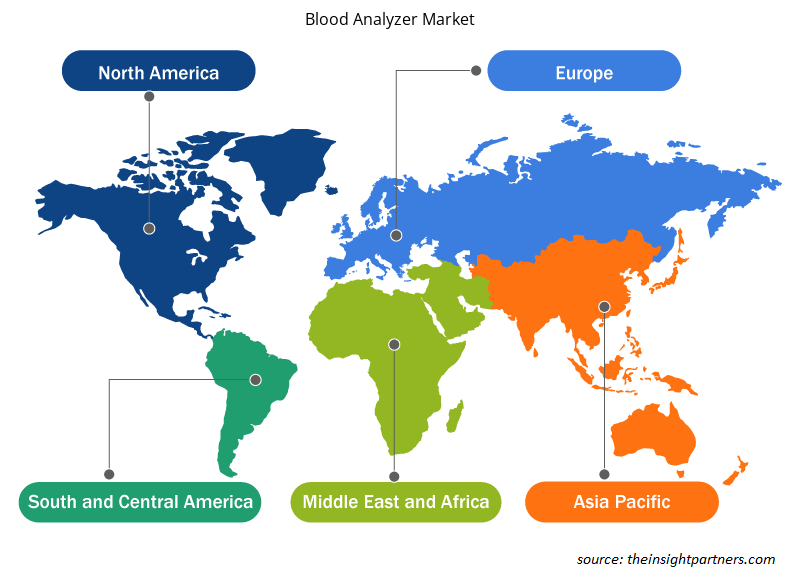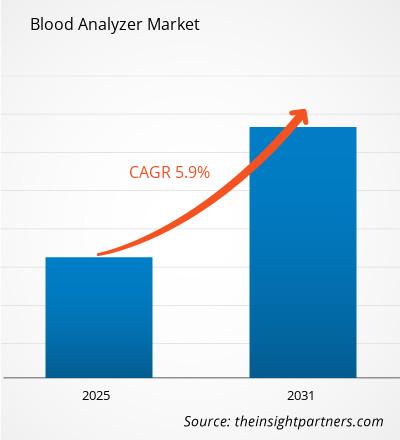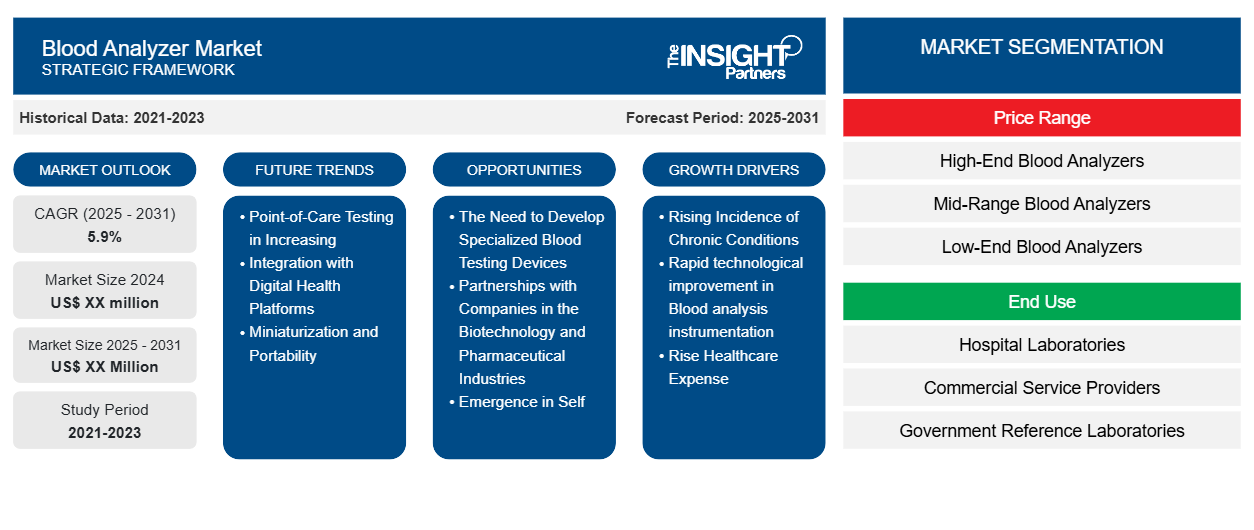血液分析仪市场预计在 2023 年至 2031 年期间的复合年增长率为 5.9%,市场规模将从 2023 年的 XX 百万美元扩大到 2031 年的 XX 百万美元。
报告按价格范围(高端血液分析仪、中端血液分析仪、低端血液分析仪)进行细分。报告进一步根据最终用途(医院实验室、商业服务提供商、政府参考实验室、研究和学术机构)进行分析。全球分析进一步细分为区域和主要国家。报告以美元为单位提供上述分析和细分的价值。
报告目的
Insight Partners 的《血液分析仪市场》报告旨在描述当前形势和未来增长、主要驱动因素、挑战和机遇。这将为各种业务利益相关者提供见解,例如:
- 技术提供商/制造商:了解不断变化的市场动态并了解潜在的增长机会,从而能够做出明智的战略决策。
- 投资者:对市场增长率、市场财务预测以及整个价值链中存在的机会进行全面的趋势分析。
- 监管机构:监管市场政策和警察活动,旨在最大限度地减少滥用行为,维护投资者的信任和信心,维护市场的完整性和稳定性。
血液分析仪市场细分
价格范围
- 高端血液分析仪
- 中档血液分析仪
- 低端血液分析仪
最终用途
- 医院实验室
- 商业服务提供商
- 政府参考实验室
- 研究与学术机构
定制此报告以满足您的需求
您可以免费定制任何报告,包括本报告的部分内容、国家级分析、Excel 数据包,以及为初创企业和大学提供优惠和折扣
- 获取此报告的关键市场趋势。这个免费样品将包括数据分析,从市场趋势到估计和预测。
血液分析仪市场增长动力
- 慢性病发病率上升:糖尿病、心血管疾病和癌症等多种疾病的发病率上升,导致血液分析仪市场具有潜在的增长潜力。全球越来越需要发明适当的诊断系统,以便及早发现和控制此类疾病。血液分析仪在这些疾病的诊断中发挥着重要作用,它提供快速准确的诊断结果,有助于及时干预和更有效地管理患者。这些健康障碍在全球范围内的流行率不断上升,可能会增加整个医疗机构对血液分析仪的需求。
- 血液分析仪器技术的快速改进:另一个最重要的驱动因素是血液分析仪器技术的快速发展。随着更先进、更高效、更省时的血液分析仪的发展,市场正在发生变化。血液分析仪的关键创新不仅是其自动化系统,还包括小型便携式设备和传感器的进步,从而提高了诊断准确性。血液分析仪中集成了人工智能和机器学习算法来解释和分析数据,提高了其可靠性和效率,因此在临床诊断中备受追捧。
- 医疗费用上涨:各国,尤其是发展中国家的医疗支出日益增长。因此,医院和诊断中心对先进诊断设备(例如血液分析仪)的支出非常高。政府和不断增加的医疗预算推动了医疗基础设施的增长。现在,由于血液检测等易于获得的诊断服务越来越多,其增长正在日益促进。
血液分析仪市场未来趋势
- 即时检验日益流行:在血液分析仪领域,即时检验的趋势日益增长,这得益于快速现场诊断测试的需求。即时检验设备可以在患者接受治疗的地方分析其血液样本,而不必远距离送往主实验室或中央实验室。即时检验在紧急环境、农村地区以及需要密切监测患者的情况下尤其重要。即时检验在家庭医疗保健和分散诊所中也越来越受欢迎。
- 与数字健康平台的集成:观察到的另一个主要趋势是与数字健康平台和电子健康记录的集成。由于医疗保健提供商拥有数据管理和存储能力,数字健康解决方案使血液分析仪的使用更加有效。借助此类解决方案,患者可以通过移动应用程序参与,而移动应用程序的移动参与通过实现决策和实时评估患者病情,增强了医疗保健服务。
- 小型化和便携性:血液分析仪的小型化已成为血液分析仪和易于在各种环境中使用方向的趋势。易于携带且体积小巧的设备非常适合医院和家庭护理使用。紧凑、样本量最小的报告设备对于无法获得医疗设施的人来说尤其有吸引力,因为方便和快速获得结果才是重中之重。这意味着这些分析仪的便携性为它们在偏远或服务不足的地区使用提供了机会。
血液分析仪的市场机会
- 开发专用血液检测设备的必要性:某些血液分析仪可以针对特定疾病目标或患者需求进行制造。例如,针对癌症生物标志物、基因研究或传染病检测的血液分析仪的需求正在增加。该公司可以利用个性化医疗需求不断增长带来的机会,设计专注于利基治疗领域的血液分析仪,这些领域的诊断解决方案对临床医生和患者更有利。
- 与生物技术和制药行业的公司合作:除上述内容外,血液分析仪制造商还可以与世界上占主导地位的制药和生物制药公司合作,进一步提高其血液分析仪的市场份额。在某些药物开发过程中,血液分析仪确定了新疗法临床试验中患者健康改善的价值。随着制药行业的增长,尤其是随着生物制剂和靶向疗法的出现,药物开发和患者监测对专用血液分析仪的需求可能会增加。
- 自我检测试剂盒的出现:家庭诊断检测的出现为血液分析仪制造商开辟了一条全新的道路。消费者越来越关注家庭健康监测,主要是因为方便、隐私和成本因素。用于测量其他健康指标水平的胆固醇和葡萄糖检测试剂盒和家庭血液分析仪越来越受欢迎。如果制造商能够设计出用户友好、准确且价格合理的家庭血液分析仪,他们就可以利用其消费者市场中快速增长的细分市场,允许更个性化地在家中管理他们的健康。
血液分析仪市场区域洞察
Insight Partners 的分析师已详尽解释了预测期内影响血液分析仪市场的区域趋势和因素。本节还讨论了北美、欧洲、亚太地区、中东和非洲以及南美和中美洲的血液分析仪市场细分和地理位置。

- 获取血液分析仪市场的区域特定数据
血液分析仪市场报告范围
| 报告属性 | 细节 |
|---|---|
| 2023 年的市场规模 | XX 百万美元 |
| 2031 年市场规模 | XX 百万美元 |
| 全球复合年增长率(2023 - 2031) | 5.9% |
| 史料 | 2021-2022 |
| 预测期 | 2024-2031 |
| 涵盖的领域 | 按价格范围
|
| 覆盖地区和国家 | 北美
|
| 市场领导者和主要公司简介 |
|
血液分析仪市场参与者密度:了解其对业务动态的影响
血液分析仪市场正在快速增长,这得益于终端用户需求的不断增长,而这些需求又源于消费者偏好的不断变化、技术进步以及对产品优势的认识不断提高等因素。随着需求的增加,企业正在扩大其产品范围,进行创新以满足消费者的需求,并利用新兴趋势,从而进一步推动市场增长。
市场参与者密度是指在特定市场或行业内运营的企业或公司的分布情况。它表明在给定市场空间中,相对于其规模或总市场价值,有多少竞争对手(市场参与者)存在。
在血液分析仪市场运营的主要公司有:
- 雅培实验室
- 贝克曼库尔特
- 堀场制作所
- 西门子股份公司
- 希森美康股份有限公司
免责声明:上面列出的公司没有按照任何特定顺序排列。

- 了解血液分析仪市场主要参与者概况
主要卖点
- 全面覆盖:报告全面涵盖了血液分析仪市场的产品、服务、类型和最终用户的分析,提供了整体概况。
- 专家分析:报告基于对行业专家和分析师的深入了解而编写。
- 最新信息:该报告涵盖了最新信息和数据趋势,确保了其与业务的相关性。
- 定制选项:此报告可以定制以满足特定客户要求并恰当地适应业务策略。
因此,血液分析仪市场研究报告有助于引领解读和了解行业情景和增长前景。尽管可能存在一些合理的担忧,但本报告的总体优势往往大于劣势。
- 历史分析(2 年)、基准年、预测(7 年)及复合年增长率
- PEST和SWOT分析
- 市场规模、价值/数量 - 全球、区域、国家
- 行业和竞争格局
- Excel 数据集
近期报告
相关报告
客户评价
购买理由
- 明智的决策
- 了解市场动态
- 竞争分析
- 客户洞察
- 市场预测
- 风险规避
- 战略规划
- 投资论证
- 识别新兴市场
- 优化营销策略
- 提升运营效率
- 顺应监管趋势





















 获取免费样品 - 血液分析仪市场
获取免费样品 - 血液分析仪市场